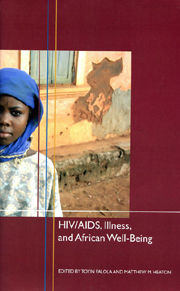Book contents
- Frontmatter
- Contents
- Acknowledgments
- Part I Context
- Part II Illness Case Studies
- Part III Globalization, Development, and Health
- 7 The Microbial Rebellion: Trends and Containment of Antimicrobial Resistance in Africa
- 8 Development and the Epidemiologic Transition in Sub-Saharan Africa
- 9 The Economic Burden of Buruli Ulcer Disease on Households in Rural Ghana
- 10 Health Issues in a Mining Community in South Africa
- 11 Globalization, Health, and the Hajj: The West African Pilgrimage Scheme, 1919–38
- Part IV HIV/AIDS
- List of Contributors
- Index
- Rochester Studies in African History and the Diaspora
7 - The Microbial Rebellion: Trends and Containment of Antimicrobial Resistance in Africa
from Part III - Globalization, Development, and Health
Published online by Cambridge University Press: 05 February 2013
- Frontmatter
- Contents
- Acknowledgments
- Part I Context
- Part II Illness Case Studies
- Part III Globalization, Development, and Health
- 7 The Microbial Rebellion: Trends and Containment of Antimicrobial Resistance in Africa
- 8 Development and the Epidemiologic Transition in Sub-Saharan Africa
- 9 The Economic Burden of Buruli Ulcer Disease on Households in Rural Ghana
- 10 Health Issues in a Mining Community in South Africa
- 11 Globalization, Health, and the Hajj: The West African Pilgrimage Scheme, 1919–38
- Part IV HIV/AIDS
- List of Contributors
- Index
- Rochester Studies in African History and the Diaspora
Summary
The Close of the Antibiotic Era?
Preventive interventions were almost entirely responsible for steep declines in infectious disease in Europe and North America in the late nineteenth and early twentieth centuries. Antimicrobial agents, chemical entities that kill or inhibit microorganisms, were developed late in the stage of this public health revolution. In parts of the world where potable water, sanitary housing, and sewage treatment are taken for granted, antimicrobials have, at least in the eyes of the public, displaced prevention as the primary tool for infectious disease control. In developing countries with suboptimal public health systems, antimicrobials are afforded a similar status and consequently greater expectations. The advent of antimicrobial chemotherapy has undeniably improved the prognosis for the individual infected patient because, save for host immunity, it is the only recourse once infection has occurred. In sub-Saharan Africa, the region that bears the greatest infectious disease burden, antimicrobials are the most commonly used class of drugs, even though their demand far exceeds their supply.
Paul Ehrlich (1854–1915) provided a conceptual definition for chemotherapeutic agents when he postulated that the ideal treatment for infection would be a chemical that would inhibit or destroy an infecting organism, or pathogen, without deleterious effects on the host. Ehrlich's search for what he described as “magic bullets” was only partially successful and the antimicrobials developed by others before and during his time were few. The noteworthy include the discovery of the antimalarial activity of Cinchona bark from South American ethnomedicine and subsequent isolation of quinine.
- Type
- Chapter
- Information
- HIV/AIDS, Illness, and African Well-Being , pp. 155 - 181Publisher: Boydell & BrewerPrint publication year: 2007



